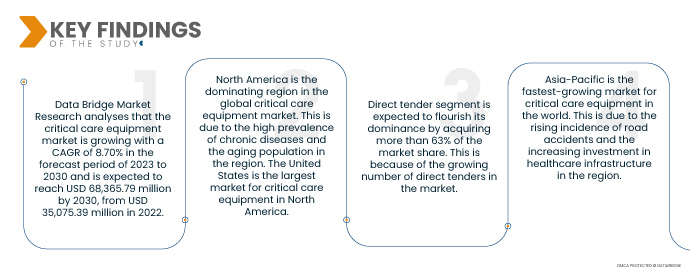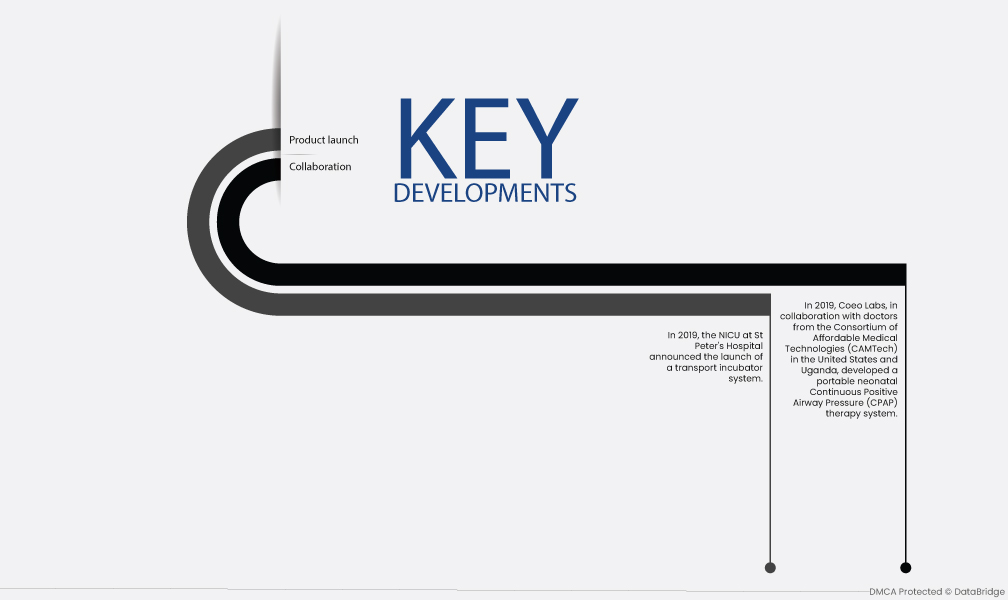According to the World Health Organization (WHO), over 15 million infants are born prematurely each year, with over 1 million dying as a result of preterm complications. One of the most difficult jobs is newborn monitoring. Better device development has remained important in controlling newborn health concerns. Manufacturers are investing heavily to meet the rising demand for neonatal critical care equipment, particularly thermoregulation devices.
Access Full Report at https://www.databridgemarketresearch.com/fr/reports/global-critical-care-equipment-market
Data Bridge Market Research analyses that the Critical Care Equipment Market is growing with a CAGR of 8.70% in the forecast period of 2023 to 2030 and is expected to reach USD 68,365.79 million by 2030, from USD 35,075.39 million in 2022. As people become more aware of the importance of critical care, they are more likely to seek treatment for critical care conditions. This is leading to an increase in the demand for critical care equipment. In some countries, reimbursement policies have been improved for critical care equipment. This has made it more affordable for hospitals and other healthcare providers to purchase critical care equipment. Governments and private investors are increasing their investment in healthcare. This investment is being used to improve healthcare infrastructure, including the availability of critical care equipment.
Growing prevalence of chronic diseases is expected to drive the market's growth rate
Chronic diseases such as heart disease, cancer, and diabetes are on the rise worldwide. These diseases can lead to critical care conditions, such as respiratory failure and sepsis. As the prevalence of chronic diseases increases, so too will the demand for critical care equipment. The global population is aging, and this is leading to an increase in the number of elderly people who require critical care. Elderly people are more likely to experience critical care conditions than younger people, due to their weakened immune systems and other health conditions. New technologies are being developed that are making critical care more effective and efficient. For example, new ventilators can provide more precise ventilation, and new monitoring devices can track patients' vital signs more closely. These advances in technology are driving the demand for critical care equipment.
Report Scope and Market Segmentation
|
Report Metric
|
Details
|
|
Forecast Period
|
2023 to 2030
|
|
Base Year
|
2022
|
|
Historic Years
|
2021 (Customizable to 2015- 2020)
|
|
Quantitative Units
|
Revenue in USD Million, Volumes in Units, Pricing in USD
|
|
Segments Covered
|
Product Type (Therapeutic Devices, Patient Monitoring Devices, Diagnostic Devices, ICU Units & System, and Other Devices), Patient Population (Neonatal, Pediatric, Adults, and Geriatric), End User (Hospitals, Specialty Clinics, Ambulatory Surgical Centers, and Others), Distribution Channel (Direct Tenders, Retail Sales, Third Party Distribution, and Others)
|
|
Countries Covered
|
U.S., Canada and Mexico in North America, Germany, France, U.K., Netherlands, Switzerland, Belgium, Russia, Italy, Spain, Turkey, Rest of Europe in Europe, China, Japan, India, South Korea, Singapore, Malaysia, Australia, Thailand, Indonesia, Philippines, Rest of Asia-Pacific (APAC) in the Asia-Pacific (APAC), Saudi Arabia, U.A.E, South Africa, Egypt, Israel, Rest of Middle East and Africa (MEA) as a part of Middle East and Africa (MEA), Brazil, Argentina and Rest of South America as part of South America
|
|
Market Players Covered
|
Koninklijke Philips N.V (Netherlands), General Electric (U.S.), Integra Life Sciences Corporation (U.S.), Edwards Lifesciences Corporation (U.S.), Getinge AB (Sweden), HEYER Medical AG (Germany), B. Braun Melsungen AG (Germany), Drägerwerk AG and Co. KGaA (Germany), Medtronic (Ireland), Fresenius SE and Co. KGaA (Germany), Smiths Medical, Inc. (U.S.), NIHON KOHDEN CORPORATION. (Japan), MAQUET Holding B.V. and Co. KG (Germany), Aeonmed (China), Shenzhen Mindray Bio-Medical Electronics Co. (China), Asahi Kasei Corporation. (Japan), Fisher and Paykel Healthcare Limited (New Zealand), Löwenstein Medical UK Ltd. (U.K.), Hamilton Medical (Switzerland), Baxter (U.S.)
|
|
Data Points Covered in the Report
|
In addition to the market insights such as market value, growth rate, market segments, geographical coverage, market players, and market scenario, the market report curated by the Data Bridge Market Research team includes in-depth expert analysis, patient epidemiology, pipeline analysis, pricing analysis, and regulatory framework
|
Segment Analysis:
The critical care equipment market is categorized into four segments based on product type, patient population, end users, and distribution channel.
- On the basis of product type, the critical care equipment market is segmented into therapeutic devices, patient monitoring devices, diagnostic devices, ICU units & system, and others. Therapeutic device segment is expected to dominate the market with a 39.06% market share due to the rise in chronic disorders such as diabetes, cardiovascular disorders, and kidney disorders, among others which is leading more patients to ICU and leading to use of more therapeutic devices.
- On the basis of the patient population, the critical care equipment market is segmented into neonatal, pediatric, adults, and geriatric. Neonatal segment is expected to dominate the market with a 41.06% market share due to the digitalization of equipment across the globe, which is expected to drive the growth of the critical care equipment market.
- On the basis of end user, the market is segmented into hospitals, specialty clinics, ambulatory surgical centers, and others. Hospital segment is expected to dominate the market with a 51.02% market share due to the rise in the geriatric population.
The hospital will dominate the end user segment of the global critical care equipment market
Hospital segment is expected to flourish its dominance by acquiring more than 51% of the market share. This is because of the growth and expansion of the healthcare industry and growing demand for critical care by geriatric population base.
- On the basis of distribution channel, the market is segmented into direct tenders, third party distribution, retail sales, and others. Direct tender segment is expected to dominate the market with a 62.54% market share due to the increasing number of patients being admitted to ICU and NICU due to the rise in chronic disorders.
The direct tender will dominate the distribution channel segment of the global critical care equipment market
Direct tender segment is expected to flourish its dominance by acquiring more than 63% of the market share. This is because of the growing number of direct tenders in the market.
Major Players
Data Bridge Market Research recognizes the following companies as the major market players: Koninklijke Philips N.V (Netherlands), General Electric (U.S.), Integra Life Sciences Corporation (U.S.), Edwards Lifesciences Corporation (U.S.), Getinge AB (Sweden), HEYER Medical AG (Germany), B. Braun Melsungen AG (Germany), Drägerwerk AG and Co. KGaA (Germany), Medtronic (Ireland), Fresenius SE and Co. KGaA (Germany), Smiths Medical, Inc. (U.S.), NIHON KOHDEN CORPORATION. (Japan), MAQUET Holding B.V. and Co. KG (Germany), Aeonmed (China), Shenzhen Mindray Bio-Medical Electronics Co. (China), Asahi Kasei Corporation. (Japan), Fisher and Paykel Healthcare Limited (New Zealand), Löwenstein Medical UK Ltd. (U.K.), Hamilton Medical (Switzerland), Baxter (U.S.).
Market Development
- In 2019, Coeo Labs, in collaboration with doctors from the Consortium of Affordable Medical Technologies (CAMTech) in the United States and Uganda, developed a portable neonatal Continuous Positive Airway Pressure (CPAP) therapy system. The portable CPAP is designed to provide respiratory support to neonates with Respiratory Distress Syndrome (RDS) during transportation. RDS is a common breathing disorder in premature babies. It occurs when the lungs are not fully developed and cannot expand properly. This can lead to respiratory failure and death. CPAP therapy helps to keep the airways open and improves breathing. The portable CPAP developed by Coeo Labs is a lightweight and easy-to-use device. It can be powered by a battery or a mains power supply. The device is also relatively inexpensive, making it more affordable for use in resource-poor settings.
- In 2019, the NICU at St Peter's Hospital announced the launch of a transport incubator system. This system is used to transport premature babies from the delivery room to the NICU and after discharge. The transport incubator provides a controlled environment for the baby, including temperature, humidity, and oxygen levels. The development of these two devices is a significant advance in the care of premature babies. They provide much-needed respiratory support and a controlled environment for transport, which can help to reduce the risk of complications and death.
Regional Analysis
Geographically, the countries covered in the market report are U.S., Canada and Mexico in North America, Germany, France, U.K., Netherlands, Switzerland, Belgium, Russia, Italy, Spain, Turkey, Rest of Europe in Europe, China, Japan, India, South Korea, Singapore, Malaysia, Australia, Thailand, Indonesia, Philippines, Rest of Asia-Pacific (APAC) in the Asia-Pacific (APAC), Saudi Arabia, U.A.E, South Africa, Egypt, Israel, Rest of Middle East and Africa (MEA) as a part of Middle East and Africa (MEA), Brazil, Argentina and Rest of South America as part of South America.
As per Data Bridge Market Research analysis:
North America is the dominant region in the critical care equipment market during the forecast period 2023-2030
North America is the dominating region in the global critical care equipment market. This is due to the high prevalence of chronic diseases and the aging population in the region. The United States is the largest market for critical care equipment in North America.
Asia-Pacific is estimated to be the fastest growing region in the critical care equipment market in the forecast period 2023-2030
Asia-Pacific is the fastest-growing market for critical care equipment in the world. This is due to the rising incidence of road accidents and the increasing investment in healthcare infrastructure in the region. China and India are the largest markets for critical care equipment in Asia-Pacific.
For more detailed information about the critical care equipment market report, click here – https://www.databridgemarketresearch.com/fr/reports/global-critical-care-equipment-market














